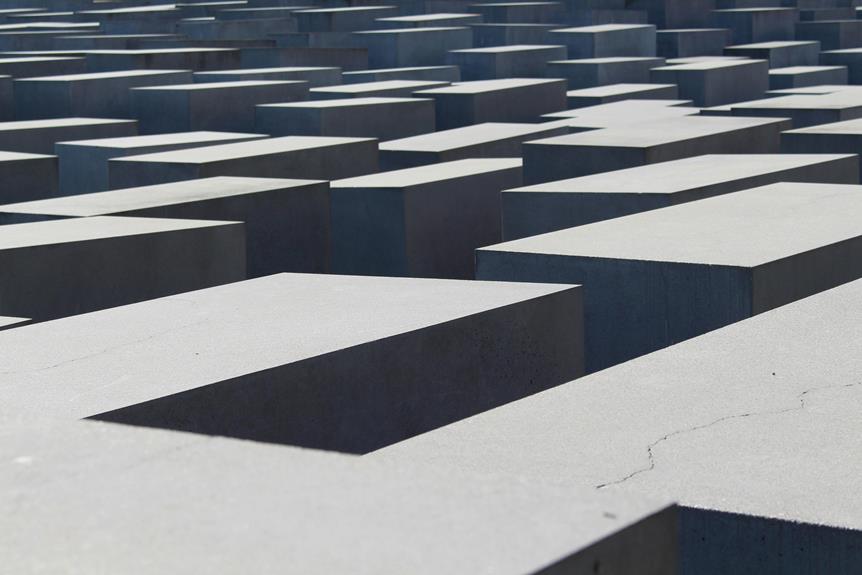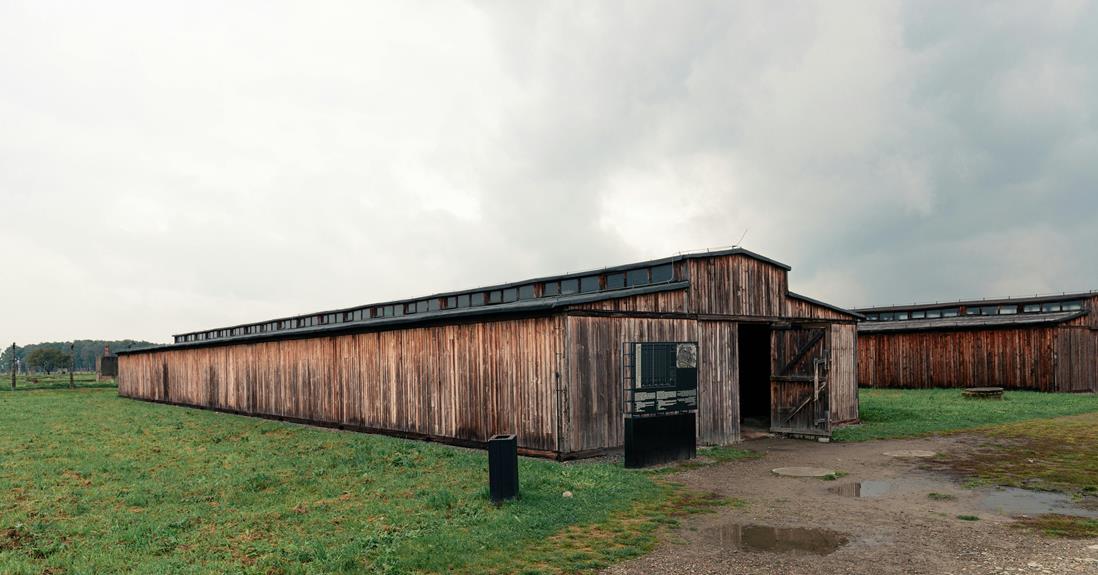Auschwitz-Birkenau, situated in Poland, stands as a solemn reminder to a dark chapter in human history. The mere mention of its name evokes a sense of reverence and reflection on the profound suffering endured within its confines. This site, meticulously planned for the systematic dehumanization and extermination of millions, holds within its gates stories of resilience, loss, and remembrance. The stark reality of Auschwitz-Birkenau beckons visitors to confront the depths of human cruelty and the enduring importance of bearing witness to the past.
Key Takeaways
- Established by Nazis in WWII as a central hub for the Final Solution.
- Divided into sections, with guard towers and grid-like barracks.
- Life marked by extreme deprivation, overcrowding, and resistance.
- Horrific medical experiments inflicted irreversible physical and psychological harm.
- Witnessed resistance, revolts, liberation, and ongoing support for survivors.
The History of Auschwitz-Birkenau
Situated in southern Poland, Auschwitz-Birkenau, established by the Nazis during World War II, stands as a solemn reminder of one of the most horrific chapters in human history. The site was initially constructed by the German forces following their occupation of Poland in 1939. This occupation marked the beginning of a dark period in which millions of innocent individuals, primarily Jews, were subjected to unimaginable atrocities within the confines of the camp.
During the Nazi occupation, Auschwitz-Birkenau became a central hub for the implementation of the Final Solution, the systematic genocide of European Jews. The camp, with its network of barracks, gas chambers, and crematoria, symbolizes the depths of human cruelty and the disregard for fundamental human rights that characterized the Holocaust.
Despite the horrors that transpired within its walls, Auschwitz-Birkenau also stands as a tribute to the resilience and strength of Holocaust survivors. These individuals, who endured unspeakable suffering and loss, have shared their stories as a stark warning against the dangers of prejudice, discrimination, and totalitarianism.
Today, Auschwitz-Birkenau serves as a poignant memorial and museum, preserving the memory of the victims and educating visitors about the atrocities committed during the Holocaust. It stands as a powerful reminder of the importance of safeguarding freedom, tolerance, and human dignity in the face of oppression and hatred.
Construction and Layout of the Camp
The layout of Auschwitz-Birkenau camp was meticulously designed to efficiently segregate and control the vast numbers of prisoners subjected to its brutal regime. The architectural design and spatial organization of the camp played an essential role in facilitating the systematic dehumanization and oppression of those incarcerated within its walls.
- Efficient Segregation: The camp was divided into different sections based on the prisoners' classifications, such as political prisoners, Jews, Roma, and others. This segregation helped the SS maintain strict control over the inmates and reinforced the ideology of division and hierarchy.
- Central Guard Towers: Strategically positioned guard towers overlooked the entire camp, enabling constant surveillance and monitoring of the prisoners' movements. This centralized control mechanism instilled fear and deterred any attempts at resistance.
- Barrack Arrangement: The barracks were arranged in a grid-like pattern, with narrow pathways separating them. This layout not only maximized the number of prisoners that could be housed within the camp but also made it easier for the SS guards to patrol and maintain order.
The meticulous planning and execution of the camp's construction reflected the insidious intent behind its creation. The architectural design and spatial organization of Auschwitz-Birkenau were instrumental in perpetuating the atrocities committed within its walls, serving as a stark reminder of the depths of human cruelty and the importance of safeguarding freedom and human rights.
Life Inside the Concentration Camp
Within the confines of Auschwitz-Birkenau, the daily existence for prisoners was a harrowing ordeal marked by extreme deprivation, dehumanization, and constant fear. Survivor stories recount the harsh realities of life inside the concentration camp. Prisoners were stripped of their identities, forced to wear uniforms that reduced them to mere numbers, and subjected to grueling daily routines designed to break their spirits.
Each day, inmates woke up to the sound of guards barking orders, initiating a day filled with hard labor, inadequate food rations, and brutal living conditions. The barracks were overcrowded, with insufficient bedding and sanitation facilities, leading to rampant disease and despair. Despite these challenges, prisoners attempted to maintain shreds of humanity through acts of solidarity and resistance.
Survivor testimonies reveal the psychological toll of living in constant fear of arbitrary violence, humiliation, and death. The pervasive atmosphere of terror made even the most basic interactions a test of survival. The daily routines of roll calls, forced marches, and harsh punishments served to reinforce the regime of terror imposed by the Nazi authorities.
The Horrors of Medical Experiments
Amidst the atrocities of Auschwitz-Birkenau, the victims were subjected to a series of barbaric medical experiments that defied all ethical boundaries. These experiments, conducted by Nazi doctors in the name of pseudoscience and racial purity, inflicted unimaginable suffering on the prisoners. The ethical dilemmas raised by these heinous experiments continue to haunt discussions on medical ethics and human rights.
- Dehumanization: The victims of these experiments were stripped of their basic human rights and reduced to mere subjects for the cruel curiosity of the researchers.
- Lack of Consent: The individuals subjected to these experiments had no say in their participation, violating the fundamental principle of informed consent in medical research.
- Irreversible Harm: The experiments often resulted in permanent physical and psychological damage to the victims, highlighting the disregard for human life and dignity.
The horrors of the medical experiments at Auschwitz-Birkenau serve as a stark reminder of the darkest depths of human depravity. The legacy of these atrocities underscores the importance of upholding ethical standards in medical research and the protection of human rights. It is a solemn duty to remember the suffering endured by those who were subjected to such inhumane treatment, ensuring that history never forgets the victims' voices silenced by cruelty and oppression.
Resistance and Revolts
During the harrowing existence in Auschwitz-Birkenau, acts of resistance and revolts emerged as poignant displays of defiance against the oppressive regime. In the face of unimaginable cruelty, prisoners exhibited remarkable bravery and unwavering solidarity to resist the dehumanization they were subjected to.
One prominent act of resistance was the Sonderkommando uprising in October 1944. The Sonderkommandos, who were forced to work in the gas chambers and crematoria, staged a courageous revolt. Despite facing almost certain death, they fought against their captors, providing a glimmer of hope amidst the despair that permeated the camp.
Additionally, individuals like Rosa Robota and other members of the Jewish underground smuggled explosives to fellow inmates in an attempt to sabotage the machinery of mass murder. These acts of resistance, though dangerous and often met with severe repercussions, symbolized the indomitable spirit of those who refused to be passive victims.
Furthermore, instances of solidarity were prevalent within the camp. Whether through sharing meager rations, providing comfort to the sick, or offering support during moments of despair, prisoners displayed a remarkable sense of unity in the face of adversity. This solidarity not only provided emotional strength but also served as a potent form of resistance against the dehumanizing tactics of the Nazis.
Liberation and Aftermath
The aftermath of the liberation of Auschwitz-Birkenau in 1945 brought to light the profound impact of the atrocities committed within its walls on both the survivors and the world at large. As the world grappled with the horrors that had taken place, recovery efforts began to aid those who had endured unimaginable suffering at the hands of the Nazis. Survivor testimonies played an important role in documenting the harrowing experiences faced within the concentration camp.
- Psychological Support: Mental health professionals and support groups were mobilized to assist survivors in coping with the trauma they had endured. The psychological scars ran deep, and it was essential to provide adequate support to help individuals rebuild their shattered lives.
- Physical Rehabilitation: Many survivors were in a weakened state due to malnourishment and harsh living conditions. Medical teams worked tirelessly to provide necessary medical care, nutrition, and rehabilitation to help survivors regain their strength and health.
- Reintegration into Society: The process of reintegrating survivors back into society was a complex one. Many faced challenges in readjusting to a world that had been unaware of the atrocities they had suffered. Social services and community support played an important role in helping survivors navigate this difficult adjustment.
Through these recovery efforts and the sharing of survivor testimonies, the world began to comprehend the magnitude of the horrors of Auschwitz-Birkenau, emphasizing the importance of never forgetting the past to prevent such atrocities from happening again.
Commemoration and Education
In the ongoing efforts to preserve the memory of the victims and educate future generations, commemoration initiatives and educational programs have been established to ensure that the legacy of Auschwitz-Birkenau remains a poignant reminder of the consequences of hatred and intolerance.
One of the most impactful ways in which the memory of Auschwitz-Birkenau is honored is through various memorial sites set up within the former concentration camp. These sites serve as a vital reminder of the atrocities that took place, allowing visitors to pay their respects and reflect on the horrors of the past. Additionally, educational programs play an essential role in ensuring that the lessons from Auschwitz-Birkenau are not forgotten. Through guided tours, workshops, and seminars, visitors are provided with historical context and a deeper understanding of the events that transpired in the camp.
| Memorial Sites | Educational Programs |
|---|---|
| The Wall of Death | Guided Tours |
| The International Monument | Workshops |
| The Memorial and Museum | Seminars |
These initiatives not only honor the memory of the victims but also aim to educate individuals about the importance of tolerance, respect, and the dangers of discrimination. By engaging with memorial sites and participating in educational programs, visitors are encouraged to reflect on the past and work towards building a more inclusive and compassionate society.
Frequently Asked Questions
How Has Auschwitz-Birkenau Been Preserved Over Time?
Preservation of historical sites like Auschwitz-Birkenau involves a multi-faceted approach. Techniques such as documentation, conservation, and restoration are essential for maintaining its historical significance.
Educational programs play an important role in raising awareness and ensuring the site's legacy endures. Community involvement fosters a sense of ownership and responsibility towards preservation efforts.
What Measures Are in Place to Prevent Vandalism at the Site?
In the domain of heritage protection, robust security measures are essential to safeguard sites of historical significance. Preservation efforts often incorporate advanced surveillance systems, regular patrols, and strict access controls to deter vandalism and ensure the integrity of these sacred spaces.
Are There Any Plans for Future Expansions or Renovations?
Future developments at significant historical sites are essential for preserving cultural heritage. Plans for expansions or renovations must align with the site's historical significance, ensuring authenticity is maintained while enhancing visitor experience.
Strategic considerations include balancing preservation needs with modern amenities, accessibility improvements, and educational opportunities. Collaborative efforts between stakeholders, preservation experts, and historians are vital in shaping future developments that honor the site's legacy while meeting contemporary needs.
How Are Artifacts and Personal Belongings of Victims Preserved?
Artifact preservation is a meticulous process that involves cleaning, cataloging, and storing items to prevent deterioration. When dealing with memorial items, such as those belonging to victims, special care is taken to honor their memory and maintain historical significance.
Preservation methods may include climate control, proper handling techniques, and archival storage materials. By safeguarding these artifacts, we guarantee that the stories and legacies of the victims are preserved for future generations.
What Is the Process for Selecting and Training Tour Guides?
The selection process for tour guides typically involves evaluating candidates based on:
- Their knowledge of the subject matter,
- Communication skills, and
- Ability to engage with diverse audiences.
Training techniques often include:
- A combination of historical education,
- Sensitivity training, and
- Practical experience.
This guarantees that guides are well-equipped to provide:
- Accurate information,
- Foster meaningful discussions, and
- Handle potentially challenging situations with professionalism and empathy.
Conclusion
To sum up, Auschwitz-Birkenau stands as a poignant reminder of the atrocities committed during World War II, serving as a solemn memorial to the millions who perished.
The camp's construction and layout reflect a systematic dehumanization of prisoners, with life inside marked by unimaginable horrors and suffering.
The legacy of Auschwitz-Birkenau serves as a somber confirmation to the importance of remembrance and education about the darkest chapters of human history.


